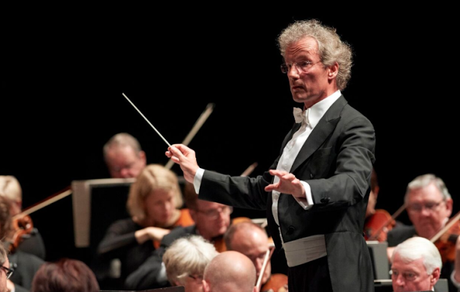by Paul J. Pelkonen

Franz Weiser-Möst led the Vienna Philharmonic on Friday night.
Photo by Michael Pöhm courtesy IMG Artists.
The arrival of the Vienna Philharmonic at Carnegie Hall is a cause for general celebration (if you have tickets) and a reason for people to swarm on the sidewalk seeking a single or a pair to hear this venerable orchestra and its unique sound. On Friday night, the Viennese gave the first of three weekend concerts under the baton of Austrian son Franz Welser-Möst.
Mr. Welser-Möst is best known to American listeners as the longtime music director of the Cleveland Orchestra, and his programming choices for this first concert reflected that ensemble's spirit of forward thinking and change. He opened with a Schubert rarity, the overture to the forgotten opera Die Zauberharfe. Schubert is on the program for all three of these concerts, and his short but productive life is an endless fount of rewards for the discerning listener. In other words, even his throw-aways are gold.
A stern introduction and a flow of melodic ideas proved an excellent re-introduction to the warm Vienna sound. After a dark, dramatic introduction, the gloom yielded for the unrolling of a finely woven carpet of lush strings. Old-style winds and brass singing the melodic second subject. Mr. Welser-M öst knows the capabilities of this orchestra and was content to let them take a free rein, which was all to the good.
Next was the New York premiere of Time Recycling by René Staar, an award-winning Austrian composer who also happens to play second violin in the VPO. Mr. Staar's work was first played in 2014 under Semyon Bychkov. It is a two-movement work that combined a number of musical approaches, with ideas in each movement reflecting in an altered repetition in the other. A vast orchestra was deployed.
The work opened with a sound that conservative listeners dread, a strident tone cluster with lashings of heavy brass. This led to complex tone-rows being laid out and an expository passage that featured world rhythms, exotic percussion and influences from multiple continents. There were some interesting ideas here, but this combination of spiky string scales, eructations from the heavy brass and persistent worldbeat did not add up in a convincing manner.
Richard Strauss wrote Ein Heldenleben when he was just 35, but this massive, autobiographical tone poem draws on personal experience and his own back catalog to create a sweeping sculpture of the composer with sound as the medium. Mr. Welser-Möst took a bold and energetic approach to the first four movements, choosing fast tempos that challenged the players to keep up. Band and orchestra transited smoothly between the epic opening movement, the snarky, scherzo-like passage depicting music critics and the roaring "battle" music, with the trumpets leading the charge from onstage and off.
The Vienna horns announced themselves with that unique tone quality that comes from their insistence on using the 19th century style valve horn in F. It also helped that they were playing the heroic theme from Strauss' Don Juan, one of thirty-odd self-quotations that pepper the second half of this work. The final movement ends with an ascending reference to the beginning of Also Sprach Zarathustra, a sunny close. The Vienna players then followed the Strauss with the other famous Strauss, with Mr. Welser-Möst leading a lilting and playful account of the Frühlingsstimmen Waltz.

